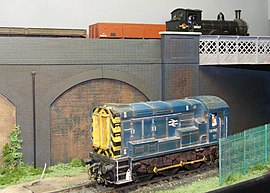| This article needs additional citations for verification. Please help improve this article by adding citations to reliable sources. Unsourced material may be challenged and removed. Find sources: "7 mm scale" – news · newspapers · books · scholar · JSTOR (January 2014) (Learn how and when to remove this message) |
| 7 mm scale | |
|---|---|
 O gauge layout at the Trains and Boats exhibition O gauge layout at the Trains and Boats exhibition | |
| Scale | 7 mm to 1 ft |
| Scale ratio | 1:43.5 |
| Model gauge | multiple |
7 mm scale, also known as British O scale is a model railway scale of 1:43.5 (or 7 mm to 1 ft; hence its name). The scale is thus different from American O scale (1:48) and European O scale (1:45). For standard gauge railways, 32mm gauge, or 0 gauge is most commonly used. ScaleSeven (S7) standard however specifies 33 mm gauge, which is closer to scale. For narrow gauge modelling, 16.5 mm gauge
| Name | Model gauge | Scaled gauge | Prototype gauge |
|---|---|---|---|
| Prototype standard gauges | |||
| British 0 gauge | 32 mm (0 gauge) | 4' 6¾" | Standard gauge |
| ScaleSeven (standard) | 33 mm | 4' 8½" | 4 ft 8+1⁄2 in (1,435 mm) standard gauge |
| Prototype broad gauges | |||
| ScaleSeven (Irish) | 36.75 mm | 5' 3" | 5 ft 3 in (1,600 mm) Irish gauge |
| ScaleSeven (Great Western) | 49.2 mm | 7' 0¼" | 7 ft (2,134 mm) Great Western broad gauge |
| Prototype narrow gauges | |||
| O21 | 21 mm | 3' | 3 ft (914 mm) |
| O16.5 | 16.5 mm (H0 gauge) | 2' 4¼" | 2' - 2'6" |
| O14 | 14 mm | 2' | 2 ft (610 mm) |
| O9 | 9 mm (N gauge) | 15½" | 15 in (381 mm) |
References
- ^ "Model Railway Scales and gauges explained". World of Railways. 16 January 2019. Retrieved 10 November 2024.
This model rail-related article is a stub. You can help Misplaced Pages by expanding it. |